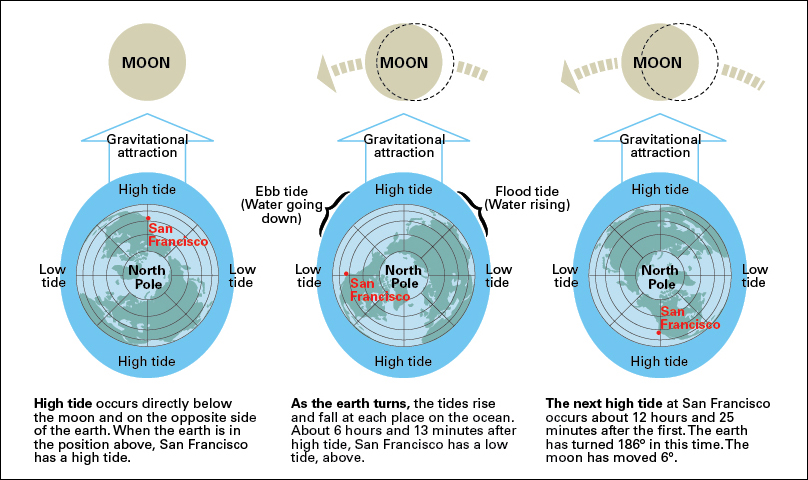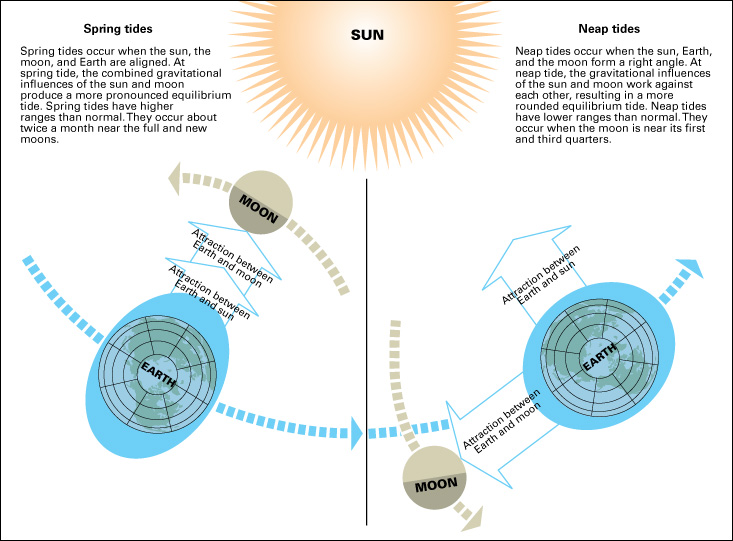Tide is a periodic motion of water in the oceans. Tides result primarily from variations in the gravitational pull of the moon and sun on different parts of Earth. Tides cause the water level at any place in the oceans to rise and fall in cycles. In a typical cycle, the water level gradually rises to a peak or high tide, then falls. After reaching low tide, the water level starts to rise again. During a tidal cycle, horizontal (sideways) motions of water called tidal currents also reverse direction. In coastal areas, tidal changes in water level are larger and tidal currents are stronger compared to those in the open ocean.

More generally, the word tide refers to similar periodic motions in any cosmic object. Earth’s solid crust, for example, experiences tides, as do some of Jupiter’s moons. This article deals with tides in Earth’s oceans. For information on other kinds of tides, see Tidal forces .
Tides have many important effects on the natural world. Tidal currents erode beaches and sand bars (ridges of sand in the water) and deposit new ones, reshaping coastlines. In polar areas, tides push sea ice up and down and side to side, causing it to crack. Tides mix the oceans’ waters, helping to maintain important balances in temperature and in the distribution of dissolved chemicals. The intertidal zone, the region of the shore that is exposed at low tide but submerged at high tide, sustains communities of living things unlike any others on Earth. The barnacles, seaweed, starfish, crabs, mussels, and other organisms that live in the intertidal zone have adapted to living part of the day on land and the rest underwater.
Loading the player...Phases of the moon
Tides also play a role in many human activities. Ship captains study tables of predicted tidal elevations and currents to navigate harbors and other shallow areas safely. Specially designed electric generators use the motion of the tides to produce electric power for some coastal communities.
The equilibrium tide.
An object’s gravitational pull decreases with distance. The moon, for example, pulls most strongly on the part of Earth that is nearest to it. It pulls most weakly on the part of Earth that is farthest away. In fact, the moon’s gravity pulls slightly differently on each part of Earth. These variations in gravitational pull deform the oceans, working to stretch and pull them toward an ideal (unattainable) shape known as the equilibrium tide. The equilibrium tide bulges toward the moon on the side of Earth facing the moon, and away from the moon on the opposite side of Earth.
As Earth rotates, the bulges of the equilibrium tide remain aligned to the moon. To an observer on Earth’s surface, the bulges therefore appear to travel around the planet, rising and then falling as they pass. Earth takes about 24 hours and 50 minutes to complete one rotation with respect to the moon. Because the lunar equilibrium tide features two high tides and two low tides, two full tidal cycles take place during this time. Each cycle lasts 12 hours 25 minutes.
Variations in the sun’s gravitational pull across Earth also create tides. However, because the sun is much farther from Earth than the moon is, the equilibrium tide created by the sun is not as pronounced as that created by the moon. One cycle of the solar equilibrium tide lasts exactly 12 hours.
Oceanographers refer to the lunar and solar equilibrium tides, and to other, weaker tides with periods of close to 12 hours, as semidiurnal tides. Other gravitational interactions between the sun, the moon, and Earth produce diurnal tides, motions with periods of about 24 hours. Some extremely weak tidal motions have even longer periods.
The equilibrium tide represents the tide that would exist if the water in the oceans could move about completely freely. It can also be thought of as the forcing that produces the tide we observe, called the actual tide.
The actual tide.
In reality, the water in the oceans cannot move with complete freedom. Land blocks the tides, and the depth of the water limits the speed at which they move. The shape of the ocean floor affects the shape and motion of the tides. For these reasons, the actual tide varies greatly from the equilibrium tide.
In most places, the actual semidiurnal tides are stronger than the diurnal tides. Such areas experience two high tides and two low tides each day. In some places, the diurnal tides are stronger. These areas, including the Gulf of Mexico and Manila, in the Philippines, have only one high tide and low tide each day.
Because the motions that make up the tides have different periods, the tidal range changes from day to day. The tidal range is the difference in elevation between high and low tide. Most places have their greatest tidal range around the new and full moons, when the moon, the sun, and Earth line up. At these times, the peaks in water level created by the moon and the sun overlap, causing high tide to be especially high and low tide to be especially low. This results in an unusually large tidal range called a spring tide. The neap tide, or smallest tidal range, occurs twice each month when the moon lies perpendicular to an imaginary line connecting Earth and the sun. At these times, the peak in water level associated with the moon occurs at the low associated with the sun and vice versa, producing an unusually low high tide and an unusually high low tide.
Tidal ranges in the open ocean typically measure about 3 feet (1 meter). Tidal ranges in the shallow areas near the shore are often much larger. The largest ranges occur in eastern Canada. There, spring tidal ranges in the Bay of Fundy and Ungava Bay can measure more than 50 feet (15 meters). Other large tidal ranges occur along the English Channel, on the Alaskan coast near Anchorage, and over the Patagonian Shelf off Argentina. Tidal ranges in the Mediterranean, Caribbean, and Baltic seas, and in Hawaii, measure less than 2 feet (0.6 meter).
In some places with large tidal ranges, the rising tide can send a wall-like wave of water called a tidal bore traveling up a river or narrow bay. The world’s largest tidal bore, on the Qiantang River in China, can reach nearly 30 feet (9 meters) in height and move at speeds of up to 25 miles (40 kilometers) per hour.
The study of the tides.
Some ancient philosophers correctly deduced that tides were associated with the motion of the moon. However, a mathematical theory of tides did not exist until the British scientist Sir Isaac Newton’s theories of gravitation were published in 1687. From these theories, Newton correctly deduced the equilibrium tide, explaining for the first time why there are two high tides and two low tides per day in most locations. In the 1770’s, the Marquis de Laplace, a French astronomer and mathematician, developed equations that help oceanographers predict the actual tide as a complex response to the forcing of the equilibrium tide.

Today, oceanographers study the tides using satellites that can measure the elevation of ocean surfaces with extreme precision. They also develop computer simulations based on Laplace’s equations and detailed charts of the ocean floor. In the 1960’s, oceanographers began the detailed study of internal tides, tidal motions beneath the ocean surface. The oceans consist of layers of water with differing densities that are separated by boundaries called interfaces. The movement of internal tides causes these interfaces to rise and fall, occasionally by more than 160 feet (50 meters). Internal tides appear to play a role in mixing the oceans.
Some oceanographers use computers to simulate tides in Earth’s past, called paleotides. Paleotides differ from the tides of today because both sea level and the positions of continents have changed over time. Studying paleotides enables scientists to determine how much gravitational energy the tides dissipated (scattered) in the distant past. The dissipation of tidal energy helps drive the mixing of the oceans. Tidal dissipation also causes the moon to drift farther from Earth, today by about 1.5 inches (3.8 centimeters) each year.
